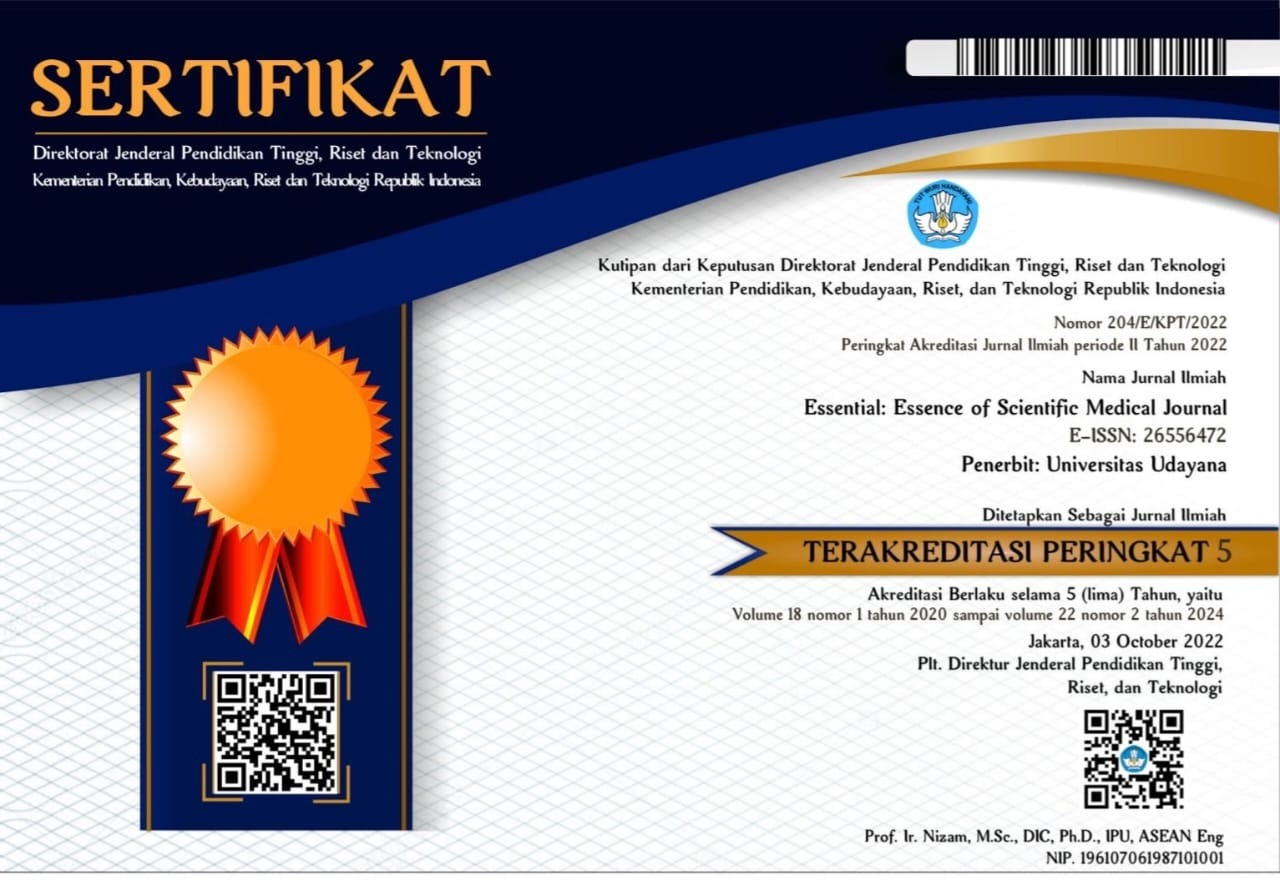Hallmarks of Cancer Dalam Aktivasi Invasi Jaringan dan Metastasis Melalui Persinyalan Adherens Junction
Abstract
Cancer is a global problem worldwide with high mortality rates. The process of cancer is studied more specifically in Hallmark of cancer. Hallmarks of cancer explains that there is one trait of cancer, namely tissue invasion and metastasis. The hallmarks of cancer tissue invasion and metastasis is responsible for >90% of cancer deaths, so this article examines how the process of invasion and metastasis in cancer development.
Downloads
References
[2] Kusmardika DA. Potensi Aktivitas Antioksidan Daun Kelor (Moringa Oliefera) dalam Pencegahan Kanker. J Heal Sci Physioterapy 2020; 2: 46–50.
[3] The Cancer Atlas. The Burden of Cancer. The Cancer Atlas 2019; 2018: 649–677.
[4] World Cancer Research Fund (WCRF) International. Worldwide cancer data | World Cancer Research Fund International. World Cancer Research Fund (WCRF) International.
[5] Rehman B, Mumtaz A, Sajjad B, et al. Papillary Carcinoma of Breast: Clinicopathological Characteristics, Management, and Survival. Int J Breast Cancer; 2022. Epub ahead of print 2022. DOI: 10.1155/2022/5427837.
[6] Alvarez EM, Force LM, Xu R, et al. The global burden of adolescent and young adult cancer in 2019: a systematic analysis for the Global Burden of Disease Study 2019. Lancet Oncol 2022; 23: 27–52.
[7] Prager GW, Braga S, Bystricky B, et al. Global cancer control: Responding to the growing burden, rising costs and inequalities in access. ESMO Open 2018; 3: 1–10.
[8] Sabnis AJ, Bivona TG, Francisco S, et al. Principles of resistance to targeted cancer therapy: lessons from basic and translational cancer biology. HHS Public Access 2020; 25: 185–197.
[9] Hanahan D. Hallmarks of Cancer: New Dimensions. Cancer Discov 2022; 12: 31–46.
[10] Rajalingam B, Priya R, Bhavani R. Multimodal medical image fusion using hybrid fusion techniques for neoplastic and Alzheimer’s disease analysis. J Comput Theor Nanosci 2019; 16: 1320–1331.
[11] Fouad YA, Carmen Aanei. Revisting the hallmarks of cancer. Am J Cancer Res 2017; 7: 62.
[12] Summer C. The Researchers Guide to the Hallmarks of Cancer Research Targets. 2017.
[13] Welch DR, Hurst DR. Defining the Hallmarks of Metastasis. Cancer Res 2019; 79: 3011–3027.
[14] Demali K. Dinamika Adherens Junction | Teknologi Pensinyalan Sel. Cell Signaling Technology.
[15] Meng W, Takeichi M. Adherens Junction: Molecular Architecture and Regulation. Cold Spring Harb Perspect Med 2009; 324: 589–597.
[16] Hartsock A, Nelson WJ. Adherens and tight junctions: Structure, function and connections to the actin cytoskeleton. Biochim Biophys Acta - Biomembr 2008; 1778: 660–669.
[17] Knights AJ, Funnell APW, Crossley M, et al. Holding Tight: Cell Junctions and Cancer Spread. Trends Cancer Res 2012; 8: 61–69.
[18] Nanes B, Kowalcyzk A. Adherens junction turnover: regulating adhesion through cadherin endocytosis, degradation, and recycling. Subcell Biochem 2015; 60: E1.
[19] Janiszewska M, Primi MC, Izard T. Cell adhesion in cancer: Beyond the migration of single cells. J Biol Chem 2020; 295: 2495–2505.
[20] Friedl P, Wolf K. Plasticity of cell migration: A multiscale tuning model. J Cell Biol 2010; 188: 11–19.
[21] Trepat X, Chen Z, Jacobson K. Cell migration. Compr Physiol 2012; 2: 2369–2392.
[22] Yamaguchi H, Condeelis J. CRegulation of the actin cytoskeleton in cancer cell migration and invasion. Biochim Biophys Acta (BBA)-Molecular Cell Res 2008; 23: 1–7.
[23] Lee SH, Dominguez R. Regulation of actin cytoskeleton dynamics in cells. Mol Cells 2010; 29: 311–325.
[24] Mcewen AE, Gottardi CJ, Escobar DE. Signaling from the Adherens Junction. Subcell Biochem 2015; 60: E1.
[25] Wheelock MJ, Johnson KR. Cadherin-mediated cellular signaling. Curr Opin Cell Biol 2003; 15: 509–514.
[26] Hodge RG, Ridley AJ. Regulating Rho GTPases and their regulators. Nat Rev Mol Cell Biol 2016; 17: 496–510.
[27] Jung H, Yoon SR, Lim J, et al. Dysregulation of rho gtpases in human cancers. Cancers (Basel) 2020; 12: 1–17.
[28] Conacci-Sorrell M, Zhurinsky J, Ben-Ze’ev A. The cadherin-catenin adhesion system in signaling and cancer. J Clin Invest 2002; 109: 987–991.
[29] Taciak B, Pruszynska I, Kiraga L, et al. Wnt Signaling Pathway in Development and Cancer. J Physiol Pharmacol 2018; 69: 185–196.
[30] Krejci P, Aklian A, Kaucka M, et al. Receptor tyrosine kinases activate canonical WNT/β-catenin signaling via MAP kinase/LRP6 pathway and direct β-catenin phosphorylation. PLoS One; 7. Epub ahead of print 2012. DOI: 10.1371/journal.pone.0035826.
[31] Paul MK, Mukhopadhyay AK. Tyrosine kinase – Role and significance in Cancer. Int J Med Sci 2012; 1: 101–115.
[32] Mahajan K, Mahajan NP. Cross talk of tyrosine kinases with the DNA damage signaling pathways. Nucleic Acids Res 2015; 43: 10588–10601.
[33] Sudhesh Dev S, Zainal Abidin SA, Farghadani R, et al. Receptor Tyrosine Kinases and Their Signaling Pathways as Therapeutic Targets of Curcumin in Cancer. Front Pharmacol 2021; 12: 1–26.
[34] Du Z, Lovly CM. Mechanisms of receptor tyrosine kinase activation in cancer. Mol Cancer 2018; 17: 1–13.
[35] Wee P, Wang Z. Epidermal growth factor receptor cell proliferation signaling pathways. Cancers (Basel) 2017; 9: 1–45.
[36] Nenclares P, Harrington KJ. The biology of cancer. Med (United Kingdom) 2020; 48: 67–72.
[37] Hunter KW, Crawford NPS, Alsarraj J. Mechanisms of metastasis. Breast Cancer Res 2008; 10: 1–10.
[38] Bielenberg DR, Zetter BR. The Contribution of Angiogenesis to the Process of Metastasis. Cancer J (United States) 2015; 21: 267–273.
[39] Zhang X, Karim M, Hasan MM, et al. Cancer-on-a-Chip: Models for Studying Metastasis. Cancers (Basel) 2022; 14: 1–23.


 SUBMISSION
SUBMISSION
















